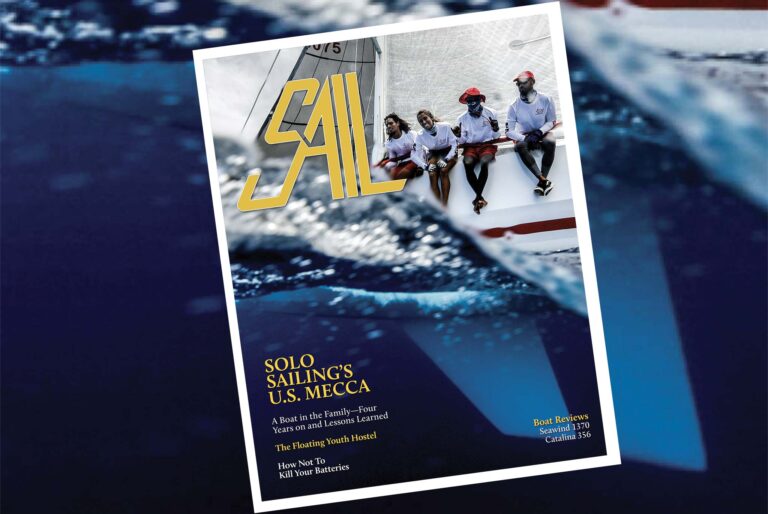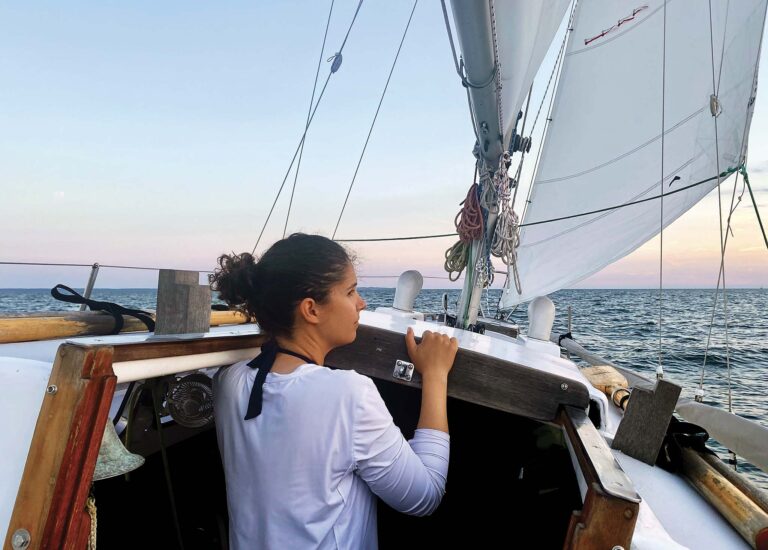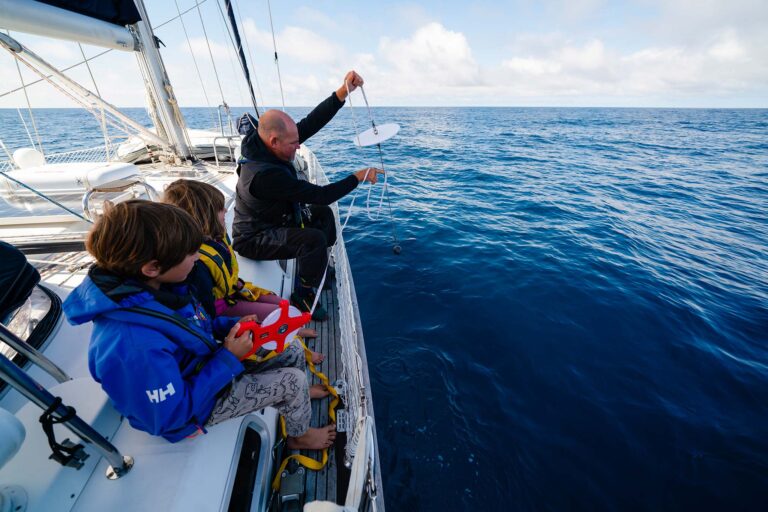
Olivia Wyatt let go of the shore in the summer of 2019, a decision slow to arrive that was part obsession, part dare, and part promise to herself. She readied herself and her sailboat, a 34-foot Ta Shing Panda named Juniper, for a solo Pacific crossing from San Diego to Honolulu.
She was a relatively new boatowner—the 30-year-old, full-keel cutter was her first (if you don’t count her Sunfish, which she named Queequeg) and remains her only. Back then she was a relatively experienced sailor as something one studies, less so as something one does. She had sailed alone before, but only a sum of 36 nautical miles and six hours. She was admittedly afraid to sail alone, which is in large part why she finally let go of that shore.
She is today, four years later, a provisional entrant in the 2026 Golden Globe Race (GGR), one of four Americans and the only woman in the field thus far. The race takes competitors from Les Sables-d’Olonne and back via four rendezvous gates and the great capes of Good Hope, Leeuwin, and Horn, solo and nonstop. In total, Wyatt has now sailed 16,000 nautical miles, 9,000 of them solo, mostly in temperate Pacific waters. The longest she has spent at sea is 23 days. Finishing the Golden Globe will require eight to ten months at sea.

“I needed a bigger purpose than cruising from place to place,” she says. “I want there to be a bigger purpose for everything I do in life. I am the type of person that wants big things to sink my entire self into. I need to be consistently challenged and learning and exploring. And I love to be consumed by a goal, otherwise I get super bored.”
Wyatt, 41, a filmmaker, photographer, and writer, is presently most of the way across the Pacific, having meandered over the years aboard Juniper through the Hawaiian island chain, across the equator to French Polynesia, then to Fiji, Vanuatu, and the Solomon Islands, arriving there in September 2023.
She has already nearly met the minimum requirements of GGR entrants—8,000 miles in any boat, 2,000 solo, and 2,000 solo nonstop in the boat you intend to use. Because she didn’t use celestial navigation, she must repeat the latter qualifier, documenting at least six celestial observations and computed position lines. This year, she will sail to Malaysia for a refit before heading for the Med in 2025, either via the Indian Ocean and Cape of Good Hope, or shipping Juniper from Thailand to Europe. She plans a final refit in Portugal before the race start in Les Sables-d’Olonne.
The idea of doing the GGR struck last summer when Wyatt was in Vanuatu, anchored off Espiritu Santo. She was aware of the original 1968 Golden Globe but not of the recent reboot until the 2022-23 edition, which Kirsten Neuschäfer won in April 2023, becoming the first woman to win a solo round-the-world race. In addition to allowing only production boats between 32 and 36 feet, designed before 1988, with a full-length keel and rudder attached to their trailing edge, the one-of-its-kind, retro race requires sailors to navigate with sextant on paper charts and use no electronic instruments or autopilot.
“I was on full fire inside,” Wyatt says. “I woke up the next day unable to shake the idea of the race out of my head, but I didn’t know if I had what it takes to do it.”
She dug further into the details and soon discovered that the Baba 35, sister vessel to her own, was on the list of pre-approved designs. She already had the right boat. In a way she had been practicing for this race for the past four years.
She reached out to Neuschäfer and another 2022-23 GGR sailor, Elliott Smith—he dropped out of the race in Australia after his rig failed—and spoke to them by phone for hours, asking questions and soaking up advice. A few days later she spoke to race founder and chairman Don McIntyre and asked him if he thought she was ready.
“You’re already doing it,” he told her. “You’re already sailing around the world by yourself.”

McIntyre, an experienced circumnavigator and consummate explorer, says the “head space” is more important than the sailing. To race the GGR requires obsession. Very few have that.
“Olivia came across as a creative dreamer with an obsession with the GGR,” McIntyre says. “Being obsessed is critical even if you do not completely understand why. The important thing is that you can’t get it out of your head because your head is the only thing that will get you to the finish. Fear and uncertainty are important because without that there is nothing to gain and to drive you forward. Olivia is the classic GGR entrant.”
She took two crew while in Hawaii and to French Polynesia, but all the other miles under Juniper were sailed alone. She told McIntyre she didn’t care about the race, or winning, that she was in it for the adventure. He told her the only goal should be to finish, because very few do. Five of 18 starters finished the 2018 race; five of 16 also finished the 2022 race, although two made stops and were thus relegated to the Chichester class.
If racers are driven by records and trophies and cruisers by the sundowners and scenery, Wyatt is something else—the communion with nature, the transformation, the epiphanies and enlightenment. She is a soul sailor, animated by the solitude of the long journeys, where lately she has been finding God.
“I’m super spiritual,” she says, “and for me, my dreams are direct messages from God. They are like the little lighthouses illuminating my life, guiding me, warning me, teaching me, healing me. The fact that my dreams about the GGR left me with such a sublime feeling indicated to me that I was being guided to do this race.”
She received more evidence of divine intervention: She started her GGR application with no money for the partial entry fee sailors are required to submit with their applications. On the day Wyatt finished the paperwork, the “exact amount I needed” appeared in her account, money that her grandmother had left her, money that Wyatt was unaware of until her bank had merged with her grandmother’s bank.
As a filmmaker, Wyatt will use the race as her next subject. She enlisted the help of another filmmaker, Philip Andrews, to help her rig Juniper with microphones and cameras so that she can record the journey with push-button ease. The end result will be her fourth feature-length documentary and her first since making “Sailing a Sinking Sea” in 2015 about the seafaring Moken people of Myanmar and Thailand. The film begat her life as a sailor.
“I pour myself so deep into my films that I get postpartum depression after I give birth to one,” she says. “For a while I dealt with that by just turning around and making another film. It was not healthy. Making that film made me want to turn the ocean into my home, so I did.”

Filming the GGR would be something of a career grand slam for Wyatt, a born storyteller who happens to be in the middle of her life’s most fascinating story. She has done some television production work remotely while cruising in the Pacific, including a stint producing field segments for a season of the NBC comedy “Little Big Shots,” but directing and filming while sailing the Southern Ocean is another matter. Luckily, she “multitasks like an alien,” according to Tom Celentano, a boatbuilder and sailor from Honolulu, who met her on the docks of Ala Wai Harbor and lent her some of his engineering expertise as she upgraded Juniper for her transit to Tahiti.
Celentano sailed Juniper with Wyatt off Oahu, where he works for a luxury catamaran charter business, and remembers a far different sailor who arrived from San Diego.
“Her passagemaking skills still needed some work,” Celentano says. “Her confidence levels seemed off, and to my mind she seemed to struggle with some of the technical aspects of her preparation for the Tahiti voyage.”
Three years later, having followed her Pacific voyage closely, Celentano says Wyatt’s “understanding of routing strategies, weather, and navigation have come a long way…she’s arriving at new anchorages sometimes in the dead of night with far more confidence than I’d witnessed in the past. I get a sense of a real and tangible groundedness about her, her decisions, and her planning. That will be a valuable strength during the GGR.”
For better and worse, much will probably be made of Wyatt’s gender, a distinguishing factor if not a determining factor. Susie Goodall was the only woman in the 2018-19 GGR and among the last two competitors to retire when she lost her mast 2,000 miles west of Cape Horn. Neuschäfer was the lone woman in the 2022-23 field. She not only won but became the superhero of the event when she came to the rescue of fellow competitor Tapio Lehtinen, whose boat Asteria, a Gaia 36, sank in the Southern Indian Ocean.
Wyatt might end up the only woman in 2026. While some of the best sailors in the world are women, they are still very few. (Cole Brauer was not yet 30 when she was the only woman to start the Global Solo Challenge in October 2023.)
Holly Martin met Wyatt through social media in 2020 when they were both in French Polynesia. The two spent a month buddy-boating around Fiji as their friendship cemented. Martin was also cruising the world alone, having recently crossed from Panama to Marquesas in her 27-foot sloop Gecko, a trip she chronicled on her YouTube channel “Wind Hippie Sailing.”
“Olivia and I stick together because we’re a vast minority,” says Martin, who grew up in a sailing family. “It’s important to celebrate the fact that women have broken into this world, but it’s just as important to remember we’re much more than our gender. It’s a tricky line to walk. On one hand, we want to shout out to the universe that women can sail too. On the other hand, we want to be recognized for our individual accomplishments.”
Wyatt’s first challenge, in addition to getting Juniper to the start line, was the fundraising for her GGR campaign. She estimated a budget of $300,000 for the cost of refitting Juniper and buying the needed equipment and gear as well as the training. While at home in Arkansas this past winter, some friends hosted fundraising events for her in her hometown of Little Rock. She also took some time while in the U.S. to take some of the courses required of entrants, like medical training and survival at sea.
Wyatt did not grow up sailing or come from a sailing background. She got her first taste in her late 20s when a friend bought her sailing lessons as a birthday present. She was living in the Rockaways in Queens, N.Y., so she purchased a Sunfish and practiced in Jamaica Bay, sometimes sailing to her summer job as a bartender at the Bungalow Bar, which had its own dock under the Cross Bay Bridge. She also helped deliver boats and joined race crews. She got good at trimming and specific tasks but did not understand sailing as a whole until she got her own boat.
She moved to Los Angeles about 10 years ago, around the time she finished “Sailing a Sinking Sea.” She intended to make more documentaries and become a better sailor. She took advanced courses, volunteered as crew, chartered boats, and eventually bought Juniper for about $45,000.
Around then, her film work began to dry up. She took a minimum-wage job at the local West Marine to make ends meet and started studying for her 50-ton USCG captain’s license hoping she could make money as a sailor. She lived aboard Juniper, first in Marina Del Rey and later in San Diego, taking her out whenever the weather kicked up to hone her skills.
In San Diego, she met Elana Connor, who crossed the Pacific alone, and within a month she had decided to do it herself. Having envisioned doing it with a partner, she got tired of waiting. She found help from a former boatbuilder and sailor who helped train her and set up the boat for the crossing.
She likened the voyage to the “wildest drug I’ve been on.” She didn’t tell many people she planned to cross to Hawaii, because she didn’t want anyone to know if she failed. The audacity of the feat was not lost on her. She did tell her mother, also named Olivia, who was so terrified and angry she didn’t speak to her daughter for months.
“I am still horrified every time she takes off,” says her mother, who goes by Livvy. “I’ve earned every grey hair that one child can give you. Sailing by herself really has unnerved me. I’m trying to let go of my fear. I have to realize whatever happens to her out there, good or bad, she’s doing exactly what she wants to do, something she loves. She loves that boat, she loves being on that water.”
You can follow Olivia Wyatt’s journey at wildernessofwaves.com and on YouTube at Wilderness of Waves.
Hugo Kugiya is an avid cruiser and a reporter at The Baltimore Banner, where he occasionally covers sailing. A former sportswriter, he has worked as a journalist for most of his life, writing for the Associated Press, Newsday, the Seattle Times, and the Orlando Sentinel. He first learned to sail in Biscayne Bay.

April 2024










